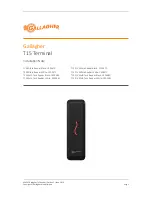
Page 14
User Guide: RFM5109-B Fixed RAIN/UHF Smart Reader with ReaderService
IN026F12 www.Axzon.com
4.
GetReaderSettings:
The reader can be con-
figured to suit your operating needs. To see
what configuration options can be modified,
the current reader settings can be retrieved.
Using this endpoint with a reader’s unique
identifier, a response is returned containing
properties that reflect the current state of
the reader, and can be provided in the pay-
load when updating the reader’s configura
-
tion.
{
“frequencyBand”: “FCC”,
“rxDecoding”: “Miller_4”,
“linkFrequency”: “_256KHz_”,
“modulation”: “PRASK”,
“qValue”: “_0_”,
“session”: “S0”,
“inventoryTarget”: “INV_TAR-
GET_A”,
“antennas”: [
{
“power”: “_DEFAULT_”,
“enabled”: true,
“id”: 1
},
{
“power”: “_DEFAULT_”,
“enabled”: false,
“id”: 2
},
{
“power”: “_DEFAULT_”,
“enabled”: false,
“id”: 3
},
5. SetReaderSettings:
Specific reader set
-
tings can be configured with this endpoint
by providing configuration properties in the
request payload. This is an important step
to ensure the reader is reader sensors ad-
equately. Settings such as link frequency,
power level and selected antenna are config
-
ured with this endpoint. A common request
body used for reading Axzon sensors might
look similar the following JSON object.
The response payload is the same shape as
the get reader configuration endpoint men
-
tioned earlier.
{
“antennas”: [
{
“enabled”: true,
“id”: 0,
“power”: “_DEFAULT_”
}
],
“defaultPropertyFileName”:
“string”,
“frequencyBand”: “FCC”,
“inventoryTarget”: “INV_TAR-
GET_A”,
“linkFrequency”: “_40KHz_”,
“modulation”: “ASK”,
“powerLevel”: “_DEFAULT_”,
“propertyFileName”: “string”,
“qValue”: “_0_”,
“readTimeout”: 0,
“rxDecoding”: “FM0”,
“selectedAntenna”: 0,
“session”: “S0”
}




































